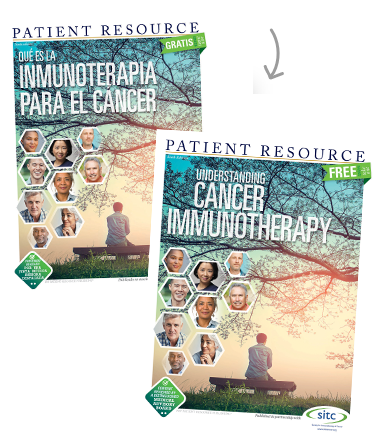Cancer Immunotherapy
Glossary of Terms
Antibody – A protein some immune cells make in response to antigens (foreign substances such as bacteria, viruses and toxins).
Antigen – Any substance that triggers an immune response. Bacteria, viruses, abnormal proteins in cancer cells, toxins and chemicals are all antigens.
Antigen-presenting cells (APCs) – Special cells that digest antigens in a way that “presents” them to T-cells and B-cells to instruct B- and T-cells to destroy cells with the “presented” antigen.
B-cells – A type of immune cell (lymphocyte) that makes proteins to mark specific foreign substances for other immune cells to destroy.
Cytokines – Proteins secreted by certain immune cells so they can communicate with each other. Cytokines can also be made in a laboratory for cancer-fighting immunotherapies.
Dendritic cell (DC) – A type of immune cell that increases the immune response. DCs can activate and stimulate other immune cells.
Immune cells – White blood cells in the immune system that help defend against cancer, infectious disease and other invaders.
Immune checkpoint inhibitors – An immunotherapy that blocks certain proteins or receptors some immune cells make. In effect, this “releases the brakes” on the immune system so T-cells can destroy cancer cells unchecked.
Immune-related adverse events (IRAEs) – The immune system’s overreaction to immunotherapy. In rare cases, IRAEs can rapidly become life-threatening without medical attention.
Immunomodulating agents – Various natural and laboratory-made substances that help boost or suppress the immune response. They are used in some types of cancer immunotherapy.
Interferon – A substance that interferes with cancer cell division and slows tumor growth, boosting the body’s immune response. A laboratory version is used as a type of cancer immunotherapy.
Interleukin – Part of a group of proteins (cytokines) that some immune cells make. Interleukin helps regulate certain functions in the immune system. A laboratory version is used in a type of cancer immunotherapy.
Lymphatic system – A network of organs and tissues that create, store and circulate lymph. Lymph (clear fluid) carries lymphocytes through the spleen, thymus, tonsils, adenoids and lymph nodes.
Lymphocyte – A type of immune cell (white blood cell) in lymph tissue and blood. The main types are B-lymphocytes (B-cells) and T-lymphocytes (T-cells), which both help the immune system fight cancer.
Monoclonal antibodies (mAbs) – Laboratory-made proteins created to target and bind with specific proteins or molecules on the surface of cancer cells. In cancer immunotherapy, mAbs are meant to stimulate an immune response in the same way naturally produced antibodies do.
Oncolytic virus – A naturally occurring virus also manufactured as a cancer immunotherapy. It targets certain cancer or tumor cells, infects them and multiplies to cause cell death. The virus can also induce an immune response.
PD-1 (programmed cell death-1) – A receptor that binds with another protein (PD-L1) to help keep the body’s immune response in check. A type of checkpoint inhibitor blocks PD-1 receptors, in effect “releasing the brakes” on the immune system.
Radioimmunotherapy – A combination of radiation therapy and immunotherapy that links a radioactive substance to a monoclonal antibody and injects it into the body. Radiation from the substance may kill cancer cells.
Receptors (immune receptors) – Surface molecules on immune cells that bind to the surface of other immune cells. This typically causes the cell to produce signals that regulate specific functions in the immune system.
T-cells – White blood cells (immune cells) that play a significant role in the immune system’s fight against infection and disease.
Tumor-infiltrating lymphocyte (TIL) – A type of immune cell that invades a tumor mass or microenvironment. A type of immunotherapy removes TIL cells from a patient’s tumor and re-engineers them in a laboratory to seek and destroy tumor-specific cancer cells.
Tumor microenvironment – The area that surrounds and sustains a tumor. It is made up of normal cells, molecules and blood vessels.
Some definitions courtesy of the website of the National Cancer Institute ( www.cancer.gov ).



